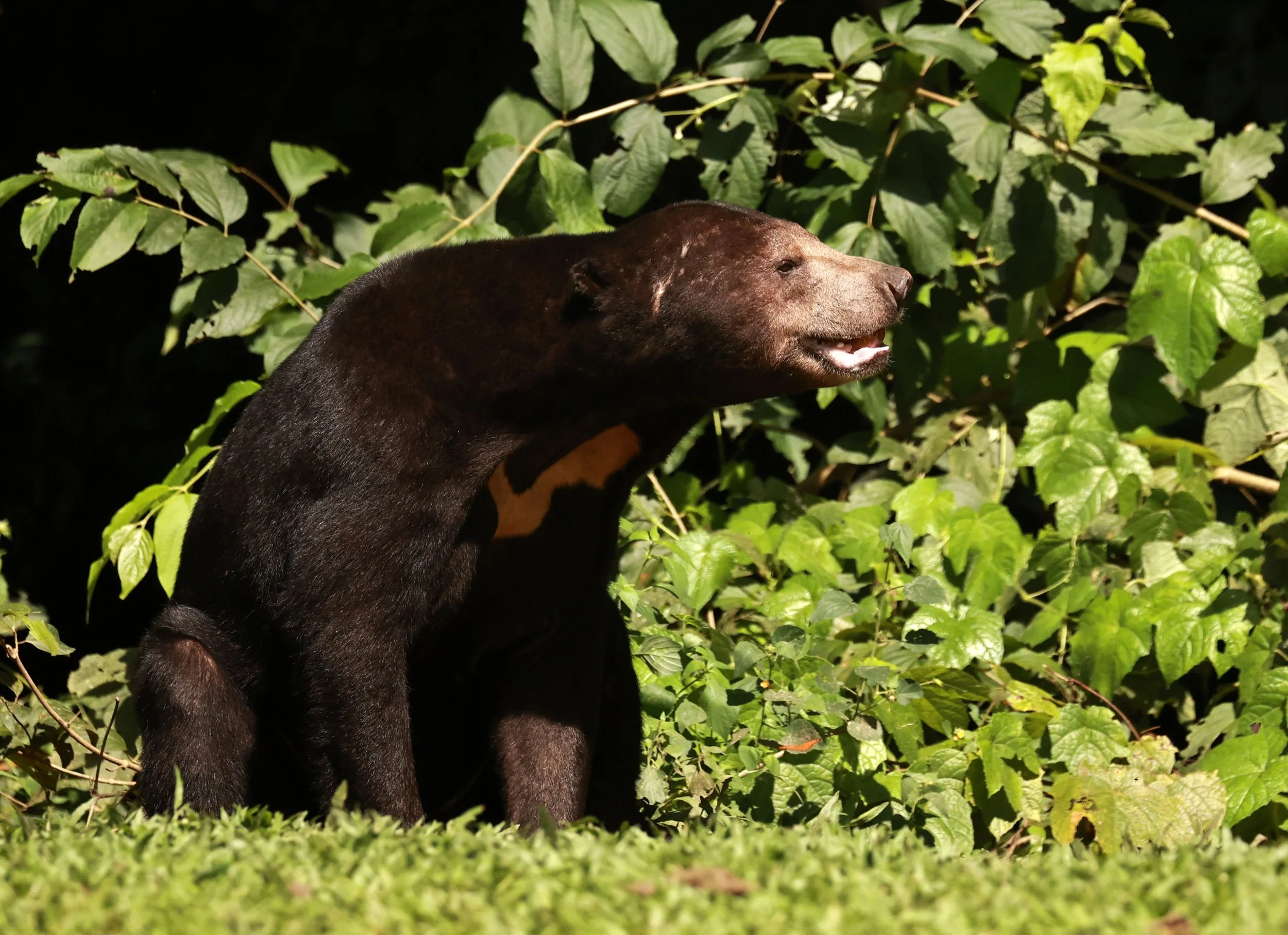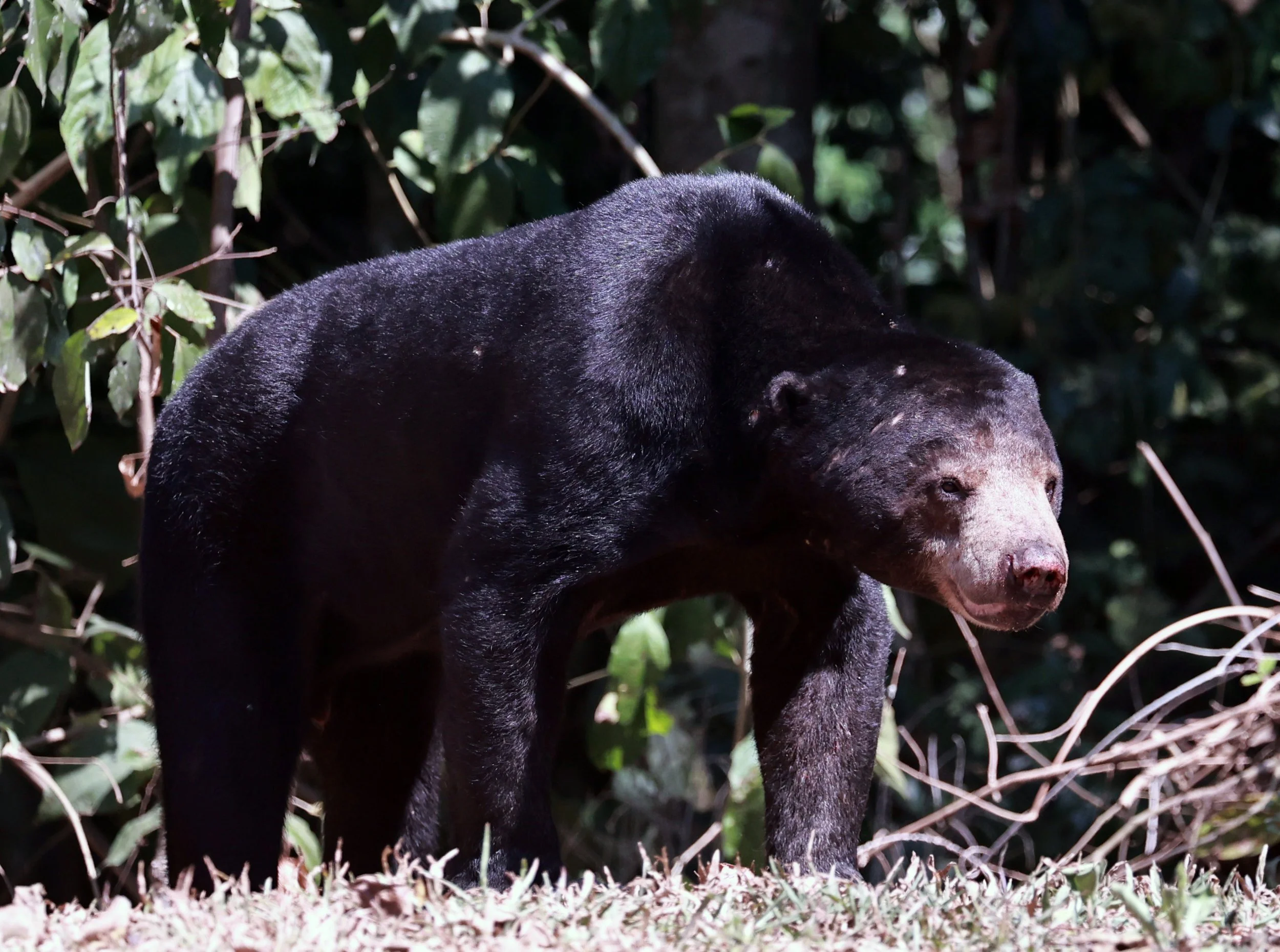
Helarctos malayanus Sun Bear
Distribution of the Sun Bear (2010)
(brown – extant, black – former, dark grey – presence uncertain)
The sun bear (Helarctos malayanus) is a species in the family Ursidae occurring in the tropical forests of Southeast Asia. It is the smallest bear, standing nearly 70 centimetres (28 inches) at the shoulder and weighing 25–65 kilograms (55–143 pounds). It is stockily built, with large paws, strongly curved claws, small rounded ears and a short snout. The fur is generally jet-black, but can vary from grey to red. Sun bears get their name from the characteristic orange to cream coloured chest patch. Its unique morphology—inward-turned front feet, flattened chest, powerful forelimbs with large claws—suggests adaptations for climbing.
The most arboreal (tree-living) of all bears, the sun bear is an excellent climber and sunbathes or sleeps in trees 2 to 7 metres (7 to 23 feet) above the ground. It is mainly active during the day, though nocturnality might be more common in areas frequented by humans. Sun bears tend to remain solitary but sometimes occur in pairs (such as a mother and her cub). They do not seem to hibernate, possibly because food resources are available the whole year throughout the range. Being omnivores, sun bears have a broad diet including ants, bees, beetles, honey, termites and plant material such as seeds and several kinds of fruits; vertebrates such as birds and deer are also eaten occasionally. They breed throughout the year; individuals become sexually mature at two to four years of age. Litters comprise one or two cubs that remain with their mother for around three years.
The range of the sun bear is bound by northeastern India to the north and extends south to southeast through Bangladesh, Cambodia, Myanmar, Laos, Thailand and Vietnam in mainland Asia to Brunei, Indonesia and Malaysia to the south. These bears are threatened by heavy deforestation and illegal hunting for food and the wildlife trade; they are also harmed in conflicts with humans when they enter farmlands, plantations and orchards. The global population is estimated to have declined by 35% over the past three decades. The IUCN has listed this species as vulnerable.
The scientific name Ursus malayanus was proposed by Stamford Raffles in 1821 who first described a sun bear from Sumatra. In 1825, Thomas Horsfield placed the species in a genus of its own, Helarctos, when describing a sun bear from Borneo.
Malayan sun bear (H. m. malayanus) at Kaeng Krachan
Two subspecies have been proposed on the basis of variations in size:
Malayan sun bear (H. m. malayanus) occurs on the Asian mainland and Sumatra.
Bornean sun bear (H. m. euryspilus) occurs only in Borneo. Its skull is smaller than that of the Malayan sun bear.
H. anmamiticus, described by Pierre Marie Heude in 1901 from Annam, is not considered a distinct species, but is subordinated as a junior synonym to H. m. malayanus. In 1906, Richard Lydekker proposed another subspecies by the name H. m. wardii for a sun bear skull, noting its similarities to a skull from Tibet with a thicker coat; however the Tibetan specimen was later found to be an Asian black bear (Ursus thibetanus). Genetic differences between the two subspecies are obscure. It is considered to be monotypic.
The phylogenetic relationships among ursid species have remained ambiguous over the years. Noting the production of fertile hybrids between sun bears and sloth bears (Melursus ursinus), it was proposed that Helarctos be treated as a synonym of Melursus. However, studies differed on whether the two species were closely related. A 2007 phylogenetic study gives the relationships of the sun bear with other species of Ursidae based on complete mitochondrial DNA sequences as shown in the cladogram below. The brown bear/polar bear genetic lineage was estimated to have genetically diverged from the two black bears/sun bear lineage around 6.72 to 5.54 million years ago (mya); the sun bear appears to have diverged from the two black bears between 6.26–5.09 mya. and 5.89–3.51 mya. Nuclear gene sequencing of bear species revealed that the sloth bear and the sun bear were the first Ursinae bears that radiated and are not included in the monophyletic Ursus group; moreover, all relationships between the bears were well resolved.
The sun bear is the smallest of all bear species. It is stockily built, with large paws, strongly curved claws, small rounded ears and a short snout. The head-and-body length is between 100 and 140 centimetres (39 and 55 inches), and the shoulder height is nearly 70 cm (28 in). Adults weigh 25–65 kilograms (55–143 pounds). The snout is grey, silver or orange. The fur is generally jet-black, but can vary from grey to red. The hair is silky and fine, and is the shortest of all bear species, suiting their hot tropical habitat. The characteristic chest patch, typically U-shaped but sometimes circular or spotlike, varies from orange or ochre-yellow to buff or cream, or even white. Some individuals may even lack the patch. Sun bears can expose the patch while standing on their hindfeet as a threat display against enemies. Infants are greyish black with a pale brown or white snout and the chest patch is dirty white; the coat of older juveniles may be dark brown. The underfur is particularly thick and black in adults, while the guard hairs are lighter. Two whirls occur on the shoulders, from whence the hair radiates in all directions. A crest is seen on the sides of the neck and a whorl occurs in the centre of the breast patch. The edges of the paws are tan or brown, and the soles are fur-less, which possibly is an adaptation for climbing trees. The claws are sickle-shaped; the front claws are long and heavy. The tail is 3–7 cm (1–3 in) long. The sympatric Asian black bear has cream-coloured chest markings of a similar shape as those of sun bears; a 2008 study discussed differences in claw markings of both bears as a means of identification. Their tongues can be over 10 inches long.
During feeding, the sun bear can extend its exceptionally long tongue to extract insects and honey. The teeth are very large, especially the canines, and the bite force is high relative to its body size for reasons not well understood; a possible explanation could be its frequent opening of tropical hardwood trees with its powerful jaws and claws in pursuit of insects, larvae, or honey. The head is large, broad and heavy in proportion to the body, but the ears are proportionately smaller; the palate is wide in proportion to the skull. The overall unique morphology of this bear—inward-turned front feet, flattened chest, powerful forelimbs with large claws—indicates adaptations for extensive climbing.
Sun bears are among the most arboreal of bears.
Sun bears lead the most arboreal (tree-living) lifestyle among all bears. They are mainly active during the day, though nocturnality might be more common in areas frequented by humans. The sun bear is an excellent climber; it sunbathes or sleeps in trees 2 to 7 metres (7 to 23 feet) above the ground. Bedding sites consist mainly of fallen hollow logs, but they also rest in standing trees with cavities, in cavities underneath fallen logs or tree roots, and in tree branches high above the ground. It is also an efficient swimmer. Sun bears are noted for their intelligence; a captive bear observed sugar being stored in a cupboard then locked by a key, and later used its own claw to open the lock. A study published in 2019 described skillful mimicry of facial expressions by sun bears, with precision comparable to that seen in some primates (such as gorillas and humans).
Sun bears are shy and reclusive animals, and usually do not attack humans unless provoked to do so, or if they are injured or with their cubs; their timid nature led these bears to be tamed often and kept as pets in the past. However, other sources state that sun bears are known as very fierce animals when surprised in the forest. They are typically solitary but are sometimes seen in pairs (such as mothers and cubs).Sun bears stand on their hindfeet for a broader view of their surroundings or smell far-off objects; they try to intimidate their enemies by displaying the chest patch if threatened. Vocalisations include grunts and snuffles while foraging for insects, and roars similar to those of a male orangutan during the breeding season; less commonly they may give out short barks (like a rhinoceros) when they are surprised. Sun bears do not seem to hibernate, possibly because food resources are available the whole year throughout the range. They occupy home ranges of varying sizes in different areas, ranging from 7 to 27 square kilometres (2+1⁄2 to 10+1⁄2 square miles) in Borneo and peninsular Malaysia; a study in Ulu Segama Forest Reserve in Sabah (Malaysia) gave the sizes of ranges as 8.7–20.9 km2 (3+3⁄8–8+1⁄16 sq mi). Tigers are major predators; dholes and leopards have also been recorded preying on sun bears but cases are relatively fewer. In one incident, a tiger-sun bear interaction resulted in a prolonged altercation and in the death of both animals. In another incident, a wild female sun bear was swallowed by a large reticulated python in East Kalimantan.
The below gallery focuses on the Sun Bears in Kaeng Krachan National Park, Thailand.






































































































































































































































































































































































































Malayan Sun Bear (Helarctos malayanus malayanus) Kaeng Krachan National Park - December 2024






































































































Malayan Sun Bear (Helarctos malayanus malayanus) Kaeng Krachan National Park - ESS Trip Jan 2025
















































Malayan Sun Bear (Helarctos malayanus) Kaeng Krachan National Park Thailand Jan 2024 - White Balance issues
















































































